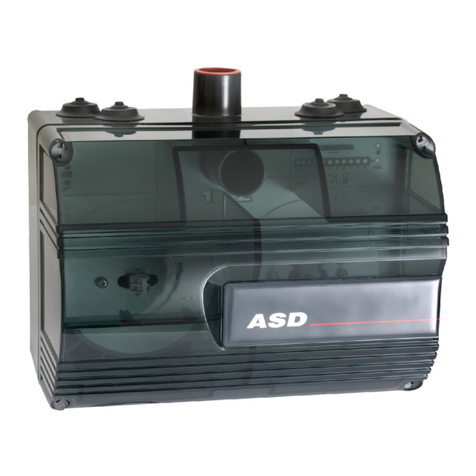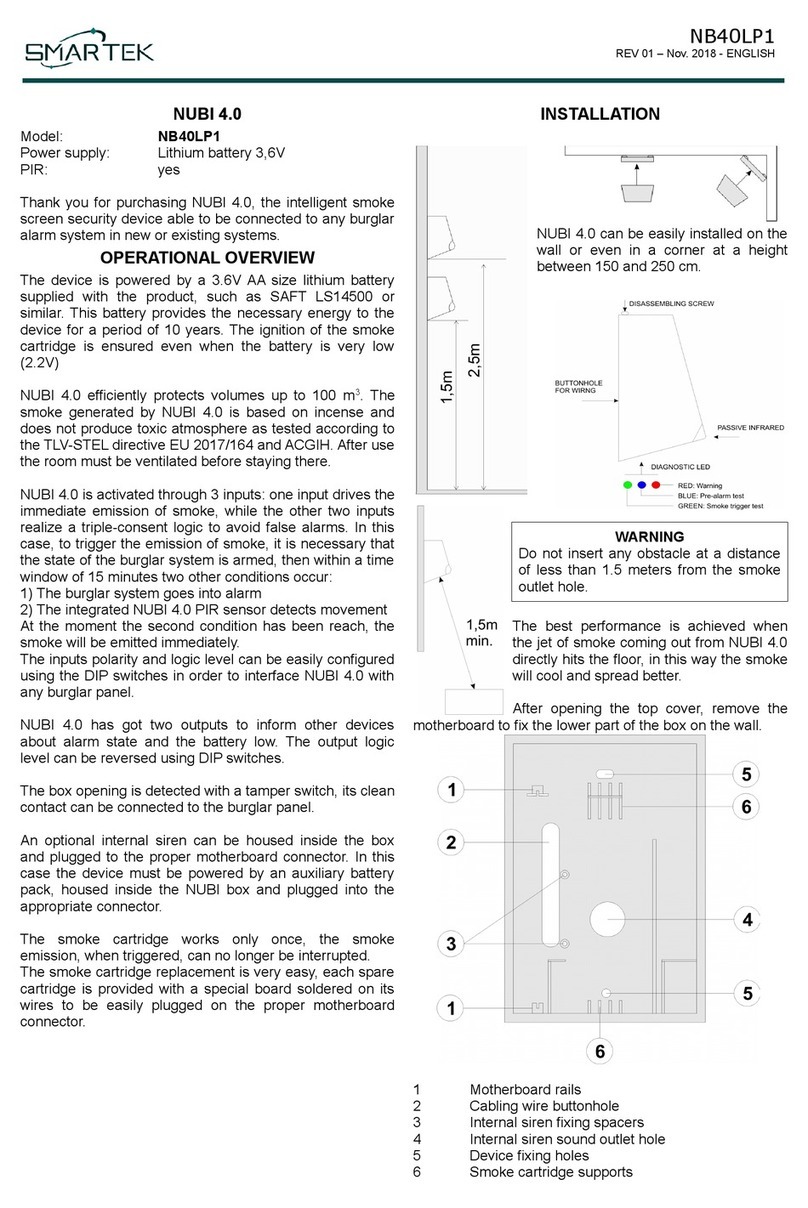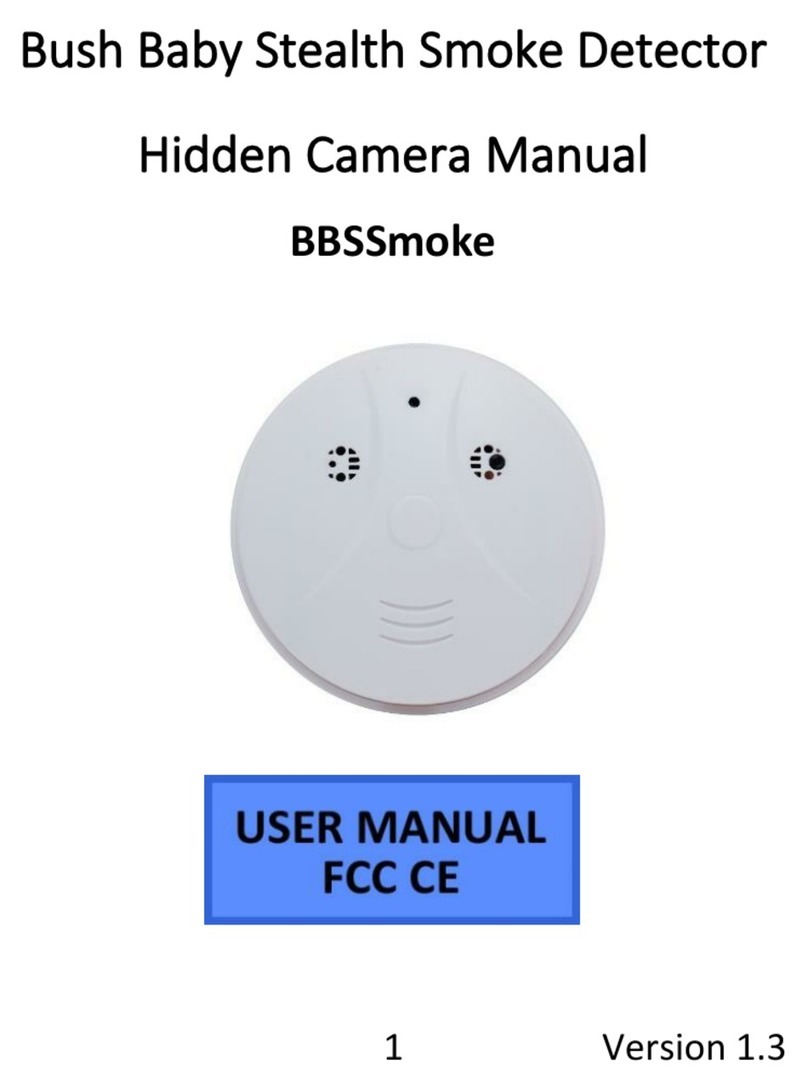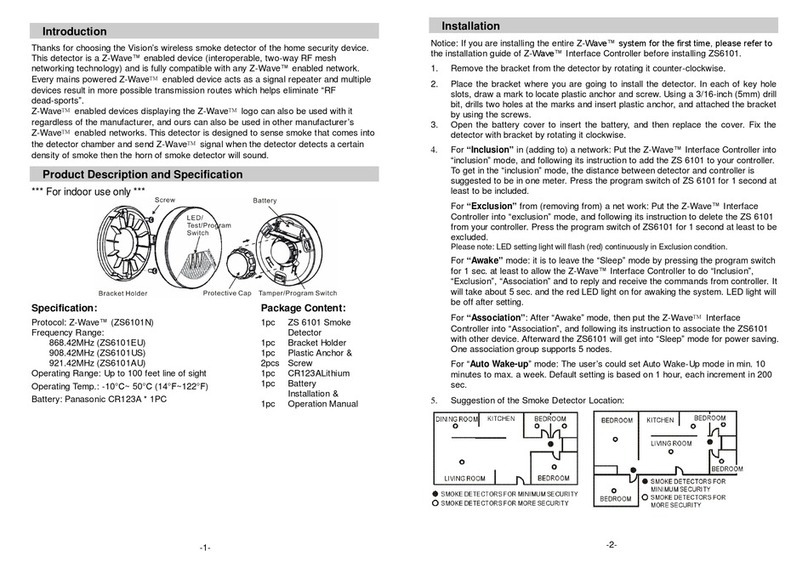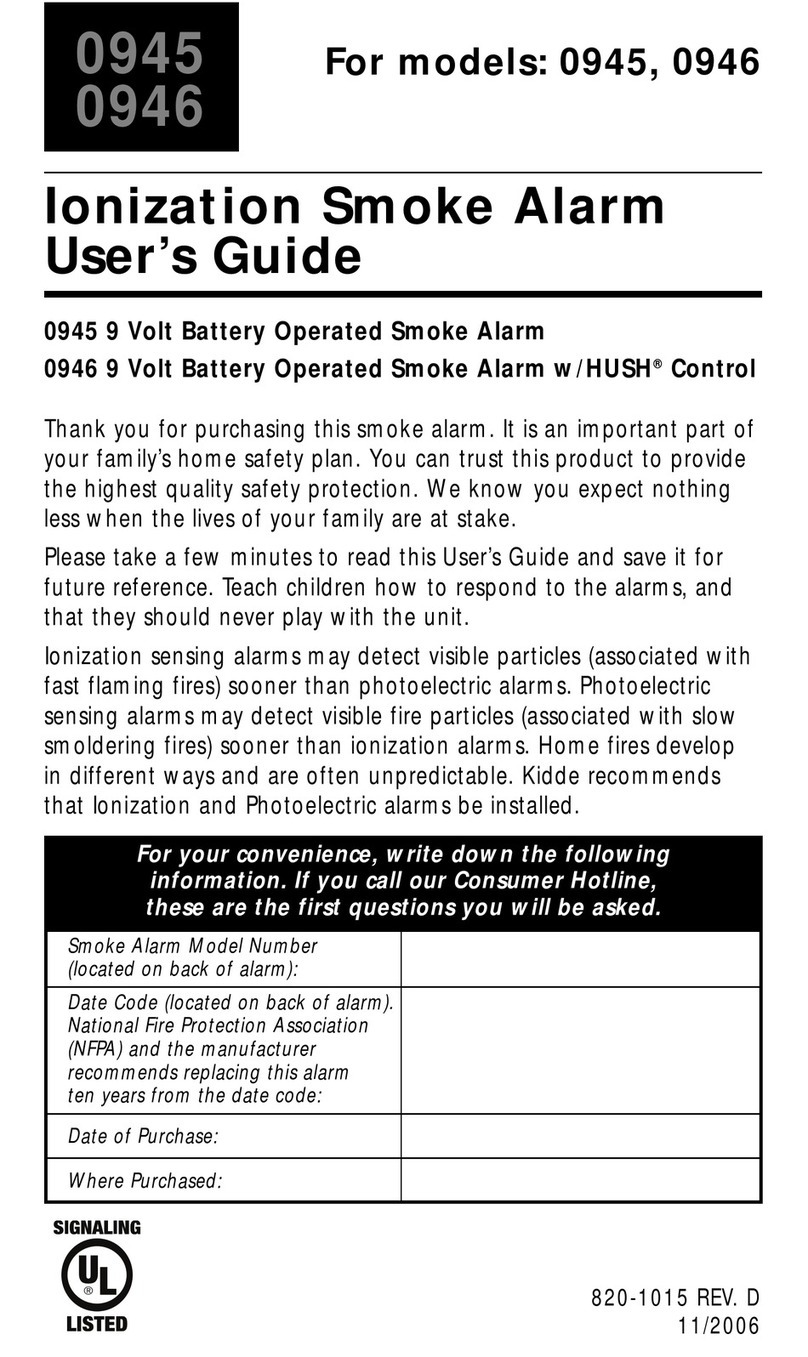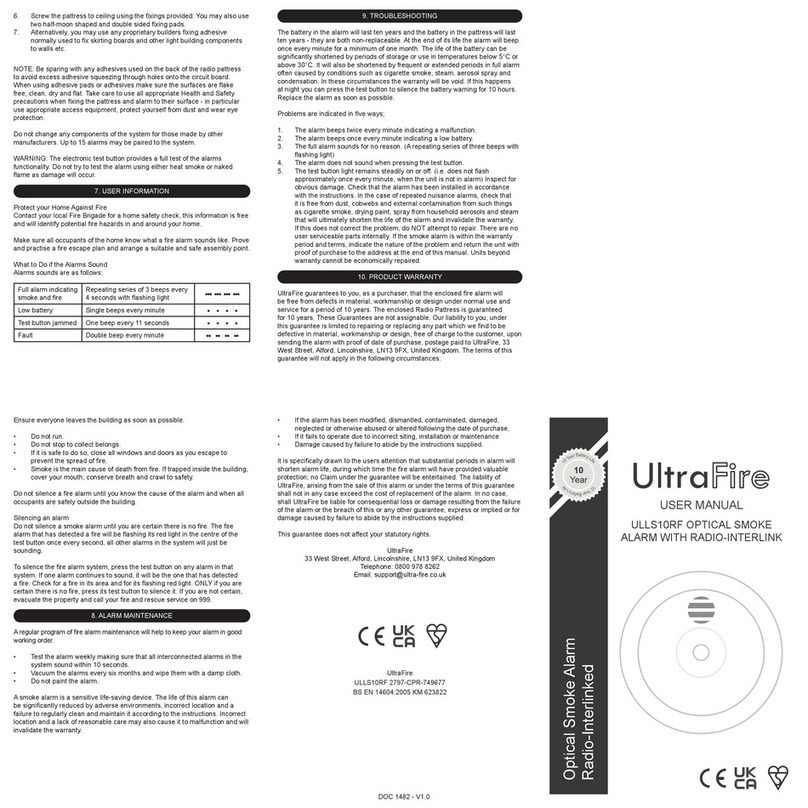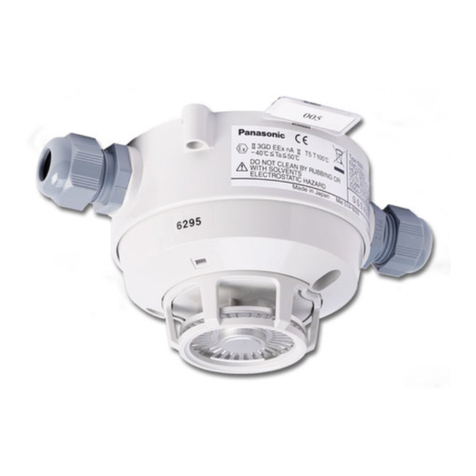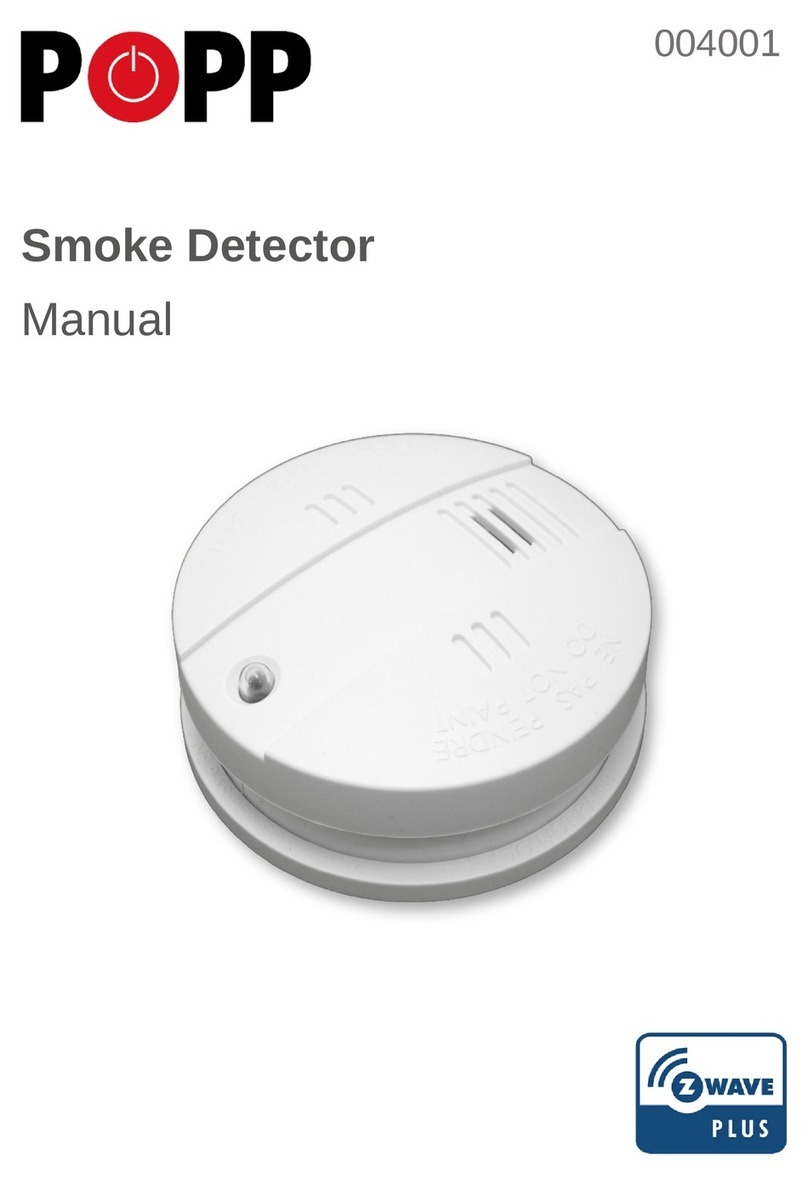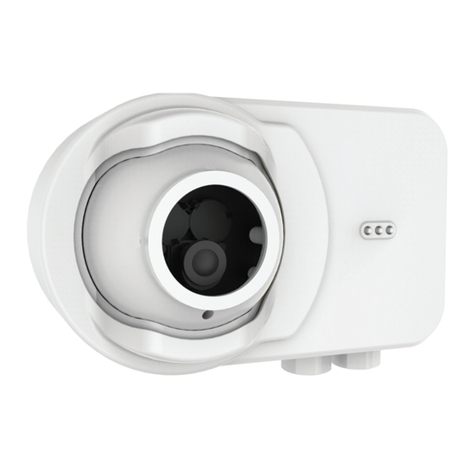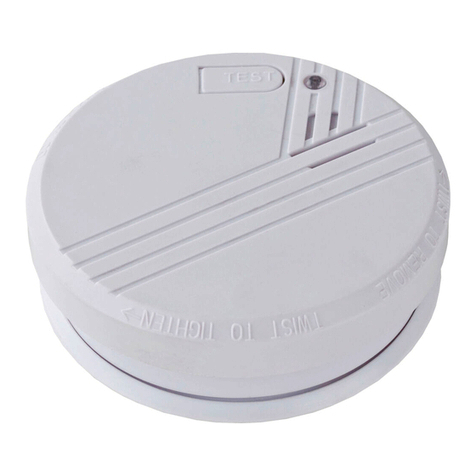Climax Technology SD-8-EL User manual

SD-8-EL Smoke Detector
Introduction
The SD-8-EL Smoke Detector is designed to be mounted on ceiling or top of stairwells where smoke would concentrate to
raise alarm timely and protect your home from fire hazards.
Parts Identification
1. Learn / Test Button
The Learn / Test Button is pressed in the following situations:
To learn in the Smoke Detector.
To test the radio communication range.
To test if the Smoke Detector is functioning normally.
To silence the alarm
2. Red/Green LED Indicator
Red LED flashes every 30 seconds – Low Battery
Red LED flashes when button is pressed – Transmit Signal
Red LED flashes continuously – Warm Up or Calibration / Alarming /Alarm Silence Mode
Green LED lights up briefly – Upon receiving acknowledgement from the Control Panel
3. Battery compartment
4. Mounting Hole
5. Mounting Bracket
6. Hook
Features
Battery
The Smoke Detector uses 3 AA Alkaline batteries as power supply.
When using factory supplied batteries, the Smoke Detector has battery life expectancy of 4 years.
When low battery voltage is detected, a low battery signal will be transmitted along with regular signal
transmissions. If the battery voltage is low, the LED will flash accompanied with a Low-volume beep every 30
seconds.
When changing batteries, remove the old batteries and press the Test button twice to fully discharge before
inserting new batteries.
Learning / Getting Started
Step 1. Insert the batteries into the battery compartment with correct polarity.
Step 2. After all 3 batteries are inserted, the Smoke Detector will sound 2 short beeps, with LED starting to flash and
begin a 6-minute warming period.
Step 3. During the 6-minute warming period, the Smoke Detector can be learnt into the Panel.
a. Put the Control Panel into learning mode. Please refer to Control Panel manual for details.
b. Press the Learn/Test button on the Smoke Detector. The LED will light up briefly and the Smoke Detector
will sound a 2-tone beep to indicate it is transmitting signal.
c. If the Control Panel successfully receives the signal, the panel will respond accordingly. Refer to Control
Panel manual to complete learning process.
Step 4. When the 6-minute warming period expires, the Smoke Detector will sound a short beep to indicate that the
Smoke Detector is starting calibration process.
The process will be repeated every 100 secs and notified by a short beep respectively. The completion of
calibration process will be notified by a 2-tone beep and the LED will be turned off.
Normally it takes about 2 ~ 16 minutes to finish calibration. However, after 16 minutes, if the Smoke Detector
gives out continuous beeps instead, it indicates that the Smoke Detector has failed calibration and its
batteries should be removed to silence the beeps. Then, please start from Step 1 to try again after a pause of
at least 30 seconds.
<NOTE>
During the calibration period, learning is disabled. If you did not finish learning (Step 3) during the 6-minute
warming period, you have to wait until the calibration has been completed (Step 4) to perform learning.
Step 5. After warming up, learning and calibration are completed, you should test the Smoke Detector’s signal
transmission range. Put the Control Panel into Walk Test mode and place the Smoke detector at desired
mounting location, and then press the Learn/Test button to transmit signal to the Control Panel.
1

If the panel can receive signal normally, proceed to mount the Smoke Detector. If signal could not be received,
change mounting location.
Installation
It is recommended that the installation site be in the center area of the ceiling, with at least 60 cm distance from
wall or obstacles.
Do not locate the detector in the following locations:
Kitchen or Garage – Smoke from cooking or vehicle might cause false alarm.
Near a ventilating fan, florescent lamp or air-conditioning equipment – air drafts from them may affect the
sensitivity of the detector.
Near ceiling beams or over a cabinet – stagnant air in these areas may affect the sensitivity of the detector.
In the peak of an “A” frame type of ceiling.
Step 1. Use the mounting bracket as template to mark the two mounting holes. Drill holes in
mounting location and insert wall plugs if needed.
Step 2. Screw the mounting bracket into marked location with the two hooks facing
downward.
Step 3. Locate the single line mark on the detector and line it up with one of the hook of the
bracket. Fit the Smoke Detector onto the hooks on the bracket, then rotate the
detector counter-clockwise to lock into place. The installation is now completed.
Testing the Smoke Detector
Press the Learn/Test button on the Smoke Detector to test if the Smoke Detector is functioning normally.
If the Smoke Detector functions normally, the LED will turn on briefly, and the Smoke Detector will sound a
2-tone beep.
If the buzzer sounds 3 times of 2-tone beep, which means the “Optical Chamber” on the Smoke Detector is
either dirty or out-of-order.
If the LED fails to light up and no beep is sounded, it means the Smoke Detector is either out-of-order or its
batteries are exhausted.
Supervisory Signal
After installation, the Smoke Detector will automatically transmit Supervisory Signals periodically to the
Control Panel at intervals of 15~18 minutes randomly.
If the Control Panel has not received the signal from the Smoke Detector for a preset period of time, the
Control Panel will consider the particular Smoke Detector out of order and react according to panel setting.
Smoke Detection
Once the concentration of the smoke exceeds the set threshold value, the Smoke Detector will transmit alarm
signal to the Control Panel and activates buzzer to sound continuous alarm for 10 seconds. The LED will flash
rapidly.
Once a Smoke Alarm Signal has been transmitted, the Smoke Detector will continue to perform follow-up
checks and send alarm signals every 2 minutes if the smoke concentration continues to exceed alarm
threshold. This 2-minute cycle will be repeated until the smoke concentration returns to normal. The alarm
can also be stopped manually by using the “Alarm Silence” function.
Alarm Silence
Once the alarm is sounding, pressing the Learn/ Test button will put the Smoke Detector into Alarm Silence
mode for 10 minutes and the alarm will be stopped.
During this 10-minute Alarm-Silence period, the LED will flash every second.
When the 10-minute period expires, the Smoke Detector will sound a 2-tone beep and then returns to normal
operation mode. If the Smoke concentration is still over alarm threshold value, the Smoke Detector will start
the alarm again.
Recalibration
As the operation condition of the smoke detector may vary after being installed for some time, you may wish to
recalibrate the smoke detector to take a new smoke detection threshold value and ensure optimal performance of
2

the smoke detector. To do this,
Press and hold the Learn/Test button for 10 seconds until the LED starts to flash. The Smoke Detector will
sound 2 short beeps, and then follow the process described in calibration process in Learning/Getting Started
section to take the new reference value
Whenever the batteries are removed and reinserted, the Smoke Detector will also recalibrate according to
previous instruction.
Auto-Calibration
After first installation, the Smoke Detector will perform auto-calibration after 4 hours. Afterwards it will perform
auto-calibration once every month. During the auto-calibration process, the Smoke Detector will not emit any
sound. Each calibration sampling process takes 2 minutes, if the process fails, it will be retried for a maximum
of 5 times. If the 5th retry fails, the LED will flash rapidly and the Smoke Detector will send calibration failure
code to the Control Panel.
The LED flashing can be cancelled by removing and reloading the batteries, or manually starting the
calibration process. However if the manual calibration fails again, the Smoke Detector will emit continuous
beeps. In this case you need to remove and reload the batteries to stop the beeping sound (please wait for 30
seconds after removing batteries before reloading them).
<NOTE>
When auto calibration fails, the smoke alarm function will still work normally using previous alarm threshold
value.
3

Federal Communication Commission Interference Statement
This equipment has been tested and found to comply with the limits for a Class B digital
device, pursuant to Part 15 of the FCC Rules. These limits are designed to provide
reasonable protection against harmful interference in a residential installation.
This equipment generates, uses and can radiate radio frequency energy and, if not installed
and used in accordance with the instructions, may cause harmful interference to radio
communications. However, there is no guarantee that interference will not occur in a
particular installation. If this equipment does cause harmful interference to radio or
television reception, which can be determined by turning the equipment off and on, the
user is encouraged to try to correct the interference by one of the following measures:
. Reorient or relocate the receiving antenna.
. Increase the separation between the equipment and receiver.
. Connect the equipment into an outlet on a circuit different from that to which the receiver
is connected.
. Consult the dealer or an experienced radio/TV technician for help.
FCC Caution: To assure continued compliance, any changes or modifications not
expressly approved by the party responsible for compliance could void the user's authority
to operate this equipment. (Example - use only shielded interface cables when connecting
to computer or peripheral devices).
FCC Radiation Exposure Statement
This equipment complies with FCC RF radiation exposure limits set forth for an
uncontrolled environment. This equipment should be installed and operated with a
minimum distance of 20 centimeters between the radiator and your body.
This transmitter must not be co-located or operating in conjunction with any other antenna
or transmitter.
The antennas used for this transmitter must be installed to provide a separation distance of
at least 20 cm from all persons and must not be co-located or operating in conjunction with
any other antenna or transmitter.
This device complies with Part 15 of the FCC Rules. Operation is subject to the following
two conditions:
(1) This device may not cause harmful interference, and (2) This device must accept any
interference received, including interference that may cause undesired operation.
4
Table of contents
Other Climax Technology Smoke Alarm manuals

Climax Technology
Climax Technology Mini-SD-HME User manual

Climax Technology
Climax Technology SD-29 Series User manual

Climax Technology
Climax Technology SD-8-EL-F1 User manual
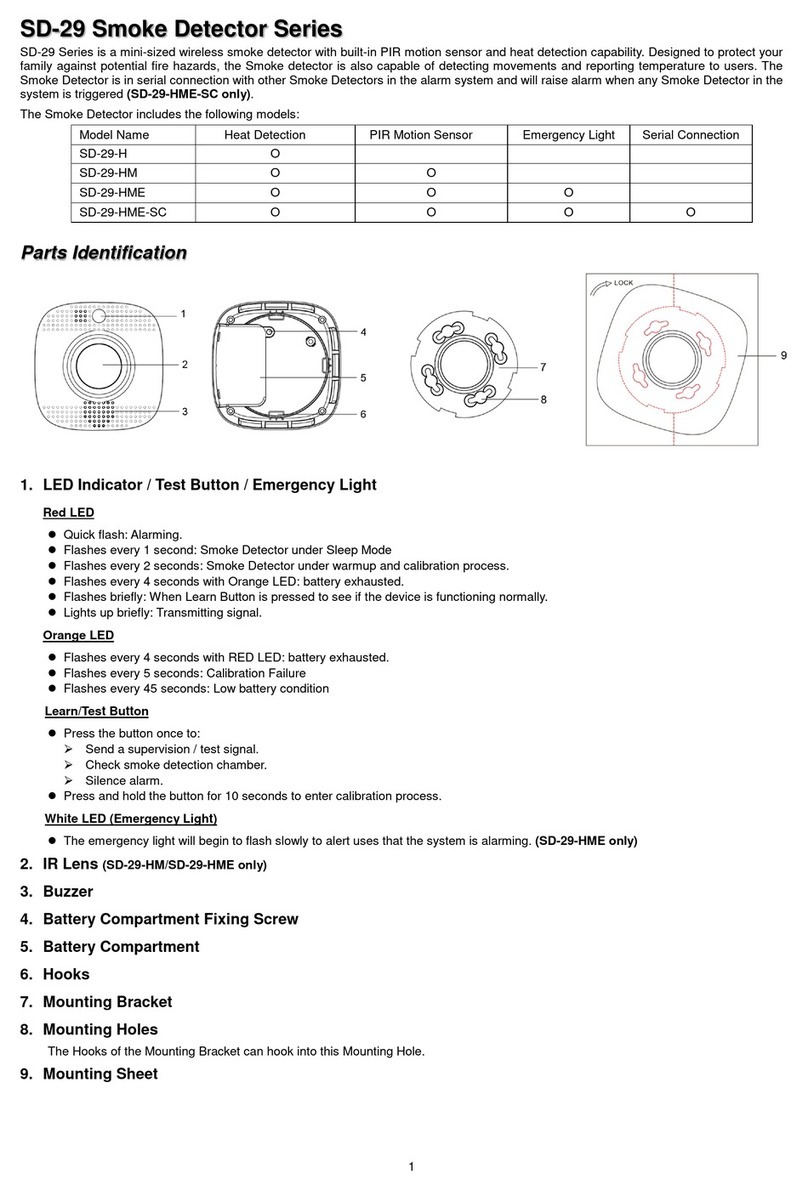
Climax Technology
Climax Technology SD-29-H User manual

Climax Technology
Climax Technology SD-29-AC-ZW Series User manual

Climax Technology
Climax Technology SDCO-1-RhTH-ZW-SC-AC User manual
Popular Smoke Alarm manuals by other brands
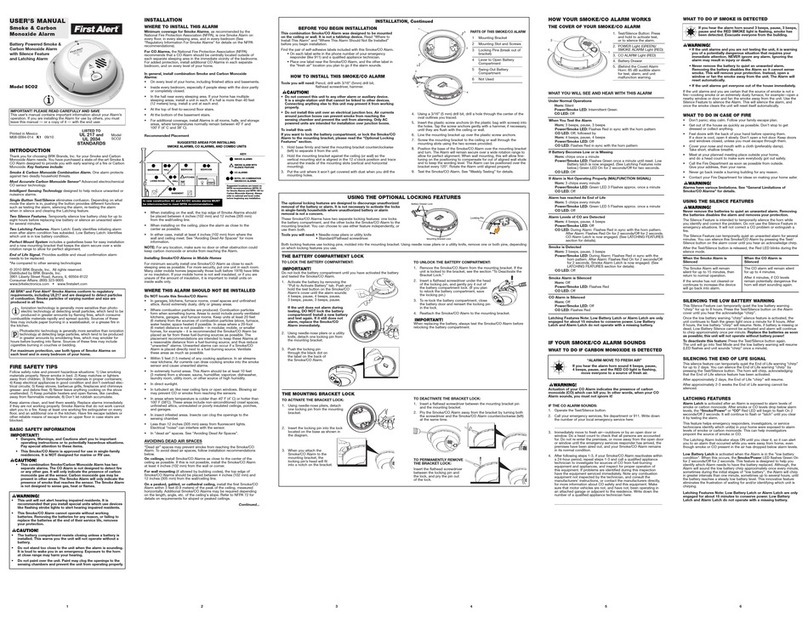
First Alert
First Alert SCO2 user manual

BRK electronic
BRK electronic 650M owner's manual
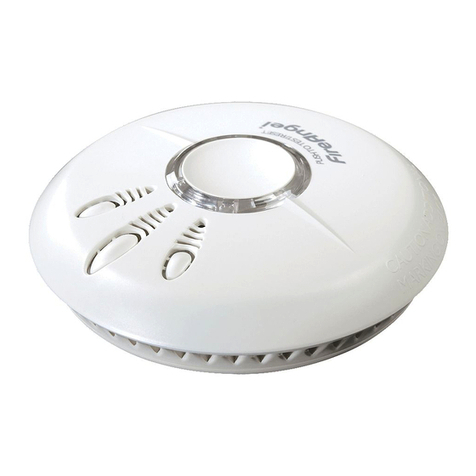
FireAngel
FireAngel SI-601 user manual
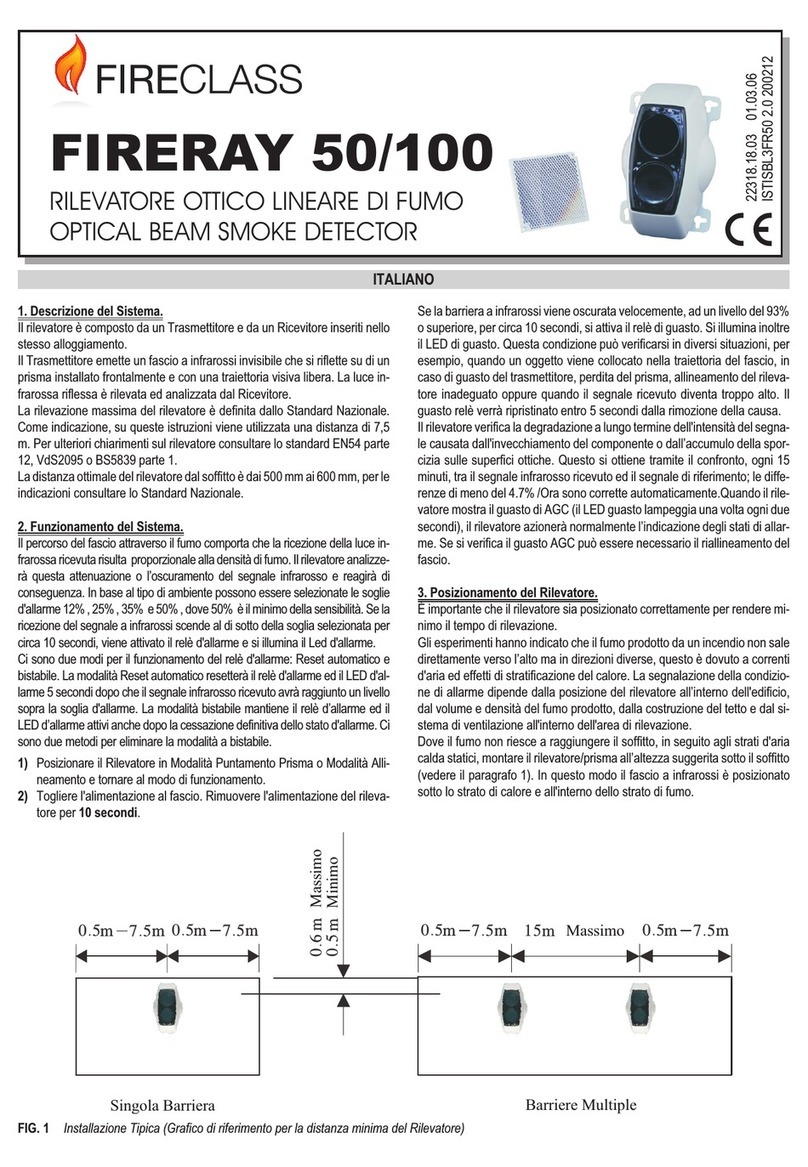
Tyco
Tyco FireClass FIRERAY 50 manual
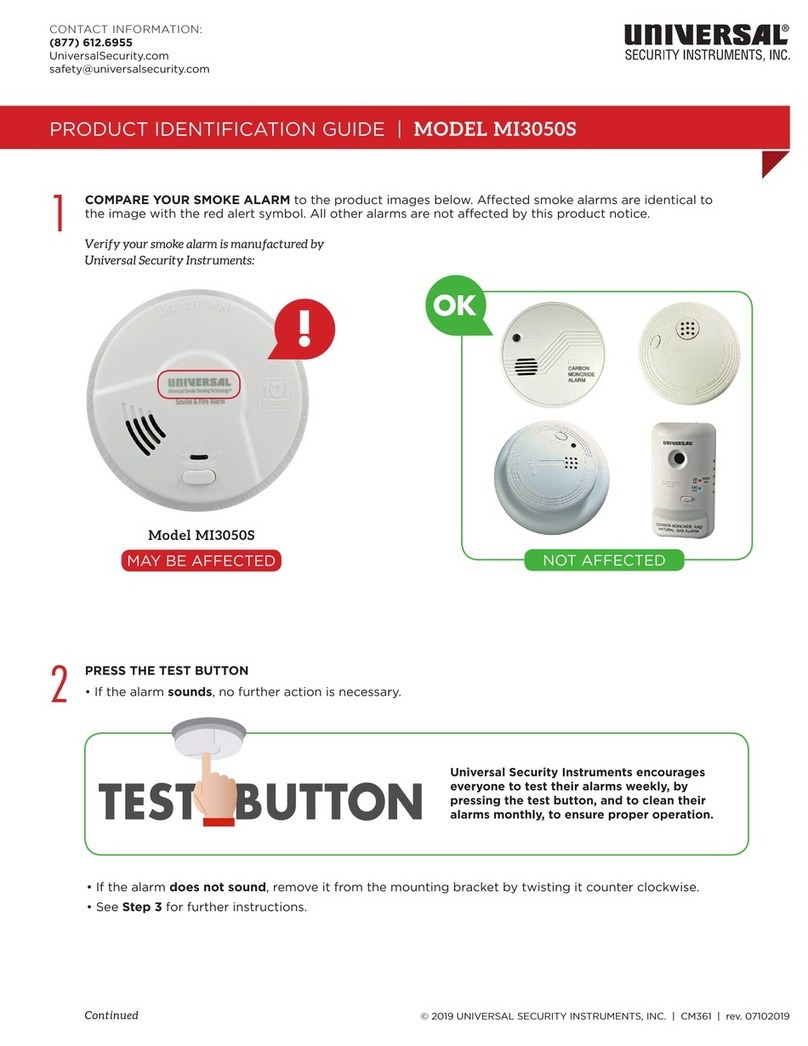
Universal Security Instruments
Universal Security Instruments MI3050S Product Identification Guide
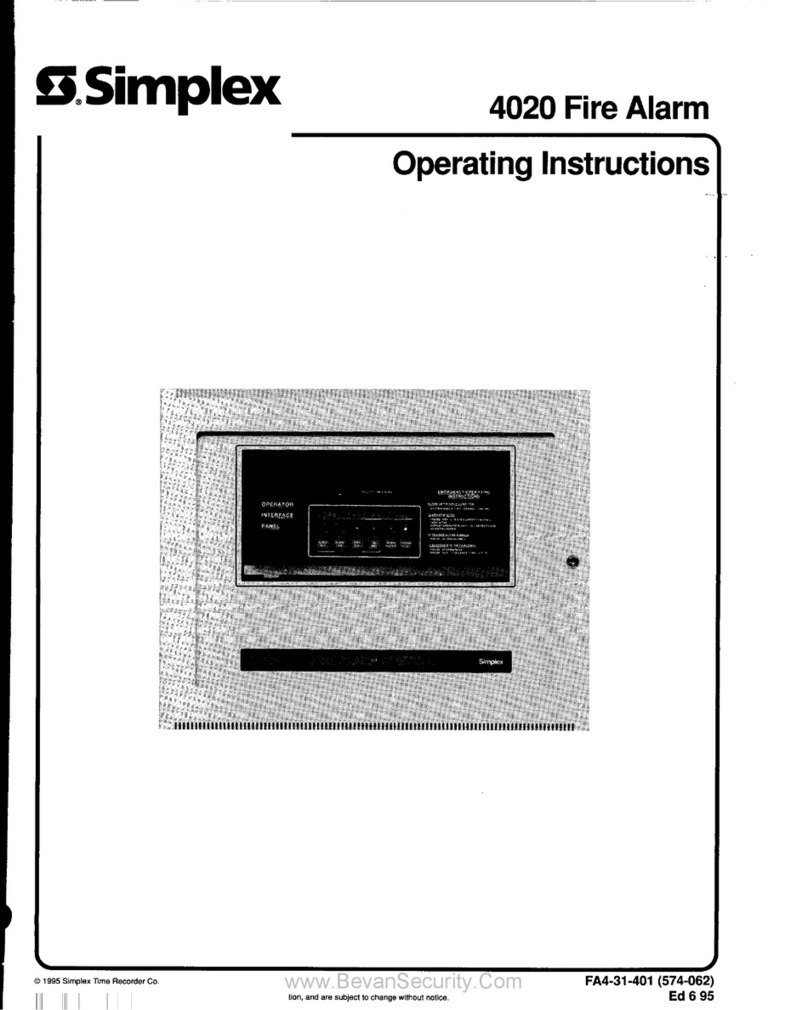
Simplex
Simplex SafeLINC 4020 Operating instruction
